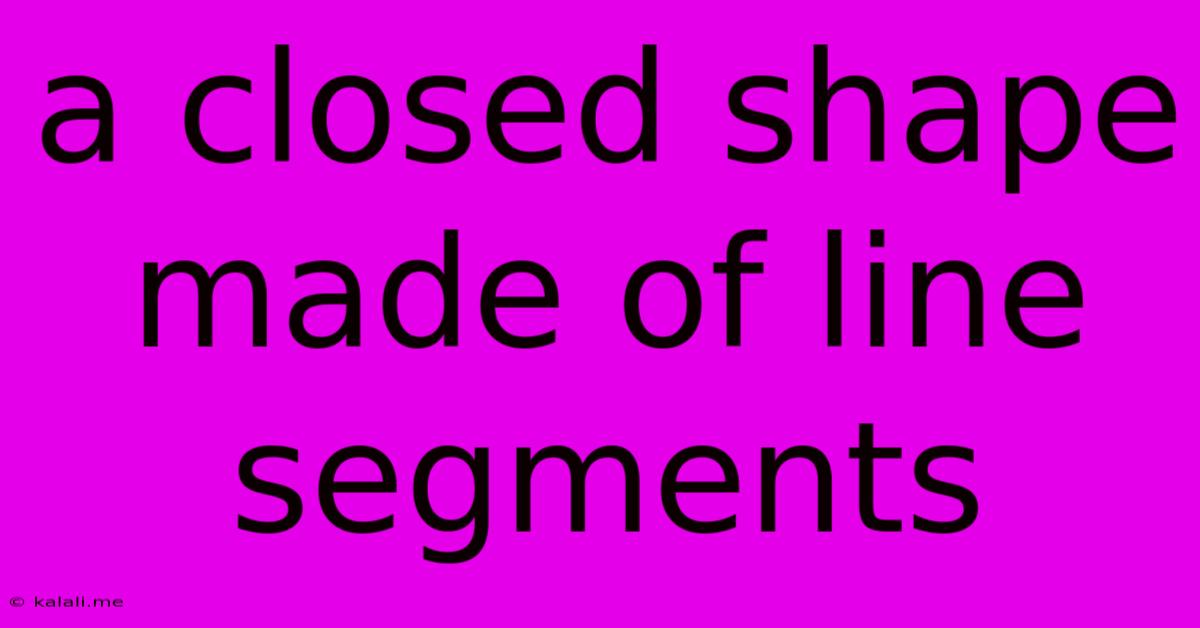A Closed Shape Made Of Line Segments
Kalali
Jun 15, 2025 · 3 min read

Table of Contents
Understanding Closed Shapes Made of Line Segments: A Deep Dive into Polygons
A closed shape made of line segments is a fundamental concept in geometry, known as a polygon. This article will explore polygons in detail, covering their properties, classifications, and applications. Understanding polygons is crucial in various fields, from computer graphics and architecture to cartography and mathematics. This article will provide a comprehensive guide to understanding these shapes, explaining key concepts in a clear and concise manner, perfect for students, hobbyists, and professionals alike.
What is a Polygon?
A polygon is a two-dimensional closed shape formed by connecting three or more straight line segments called sides or edges. These segments meet at points called vertices or corners. Crucially, the segments must only intersect at their endpoints; they cannot cross each other. Think of simple shapes like triangles, squares, pentagons, and hexagons – these are all examples of polygons. The number of sides determines the polygon's name and properties.
Key Properties of Polygons:
- Sides: The line segments forming the polygon.
- Vertices: The points where the sides meet.
- Angles: The angles formed by the intersection of two sides at a vertex. The sum of the interior angles of a polygon depends on the number of sides.
- Interior Angles: The angles inside the polygon.
- Exterior Angles: The angles formed by extending one side of the polygon. The sum of the exterior angles of any polygon is always 360 degrees.
- Diagonals: Line segments connecting non-adjacent vertices.
Classifying Polygons:
Polygons can be classified in several ways:
-
By the number of sides:
- Triangle (3 sides): Equilateral, isosceles, scalene.
- Quadrilateral (4 sides): Square, rectangle, rhombus, parallelogram, trapezoid, kite.
- Pentagon (5 sides): Regular pentagon, irregular pentagon.
- Hexagon (6 sides): Regular hexagon, irregular hexagon.
- Heptagon (7 sides)
- Octagon (8 sides)
- Nonagon (9 sides)
- Decagon (10 sides)
- And so on...
-
By their angles:
- Convex Polygon: All interior angles are less than 180 degrees.
- Concave Polygon: At least one interior angle is greater than 180 degrees.
-
By their sides' lengths and angles:
- Regular Polygon: All sides are equal in length, and all angles are equal in measure.
- Irregular Polygon: Sides and angles are not all equal.
Applications of Polygons:
Polygons are ubiquitous in various fields:
- Architecture: Building designs heavily rely on polygons for structural integrity and aesthetic appeal.
- Computer Graphics: Polygons are the building blocks of 3D models and computer-generated imagery (CGI).
- Cartography: Maps use polygons to represent geographical regions and features.
- Engineering: Many engineering designs incorporate polygons for strength and efficiency.
- Tessellations: Polygons can be arranged to create tessellations, which are patterns that cover a plane without overlaps or gaps.
Beyond the Basics:
Understanding polygons opens doors to more advanced geometric concepts like area calculations, perimeter calculations, and the exploration of complex polygons with many sides. Further study can delve into the properties of specific polygon types and their relationships to other mathematical concepts.
This article provides a foundational understanding of closed shapes made of line segments – polygons. By exploring their properties, classifications, and applications, we can appreciate their significance in mathematics and various real-world applications. Further research into specific polygon types will deepen your understanding of this fundamental geometric concept.
Latest Posts
Latest Posts
-
What Is Prime Factorization Of 180
Jun 15, 2025
-
Which Of The Following Statements Are True About Viruses
Jun 15, 2025
-
What Is The Major Product Of The Following Reaction Hbr
Jun 15, 2025
-
Is Milk Of Magnesia An Acid Or Base
Jun 15, 2025
-
How Many Teaspoons Are Equivalent To 44 Tablespoons
Jun 15, 2025
Related Post
Thank you for visiting our website which covers about A Closed Shape Made Of Line Segments . We hope the information provided has been useful to you. Feel free to contact us if you have any questions or need further assistance. See you next time and don't miss to bookmark.